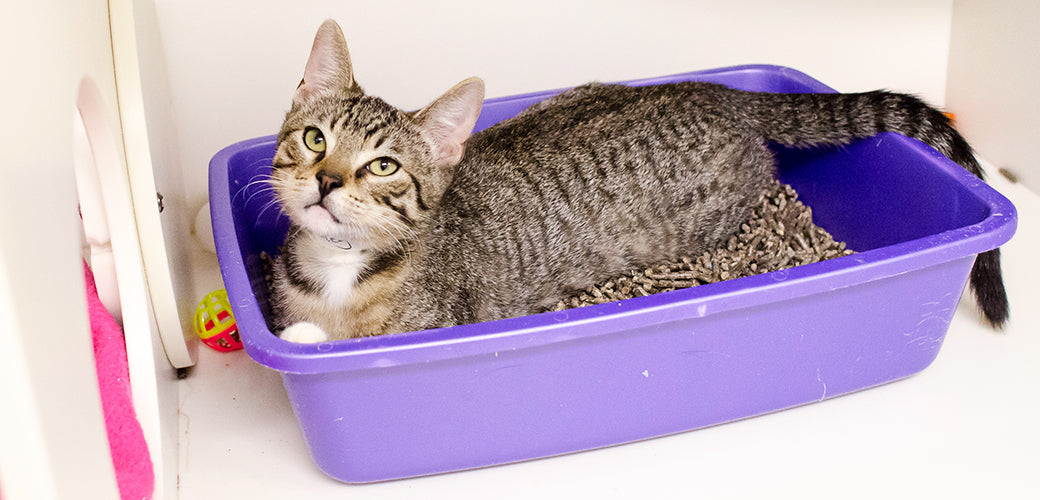Cats are naturally clean creatures, and teaching them to use their litter box encourages good home behavior and cleanliness. To do this, it is important to consider several different factors to accommodate your cat's unique preferences, such as environment and type of litter.
Here are a few tips on getting your cat to use their litter box.

Pick out a litter box that suits both you and your cat. There are various types of litter boxes that vary in size, depth, material and function. Some cats prefer boxes with deeper depth while others prefer a more shallow space. There are also automatic cleaning boxes that utilize a rake to clear the dirty litter into a storage bag. Some people even prefer to use disposable litter boxes that conveniently come with the litter already inside so that contact with waste is minimized. Plastic boxes are more durable, while cardboard boxes are easier to replace. It is best to explore different options in boxes to find what is most comfortable for your cat and what is best suitable for your cleaning preferences.

Finding the right cat litter is extremely important in litter box training. Fortunately, there are plenty of options that are available online and at many local stores. There are both scented and non-scented options with different sizes and textures. Some types of litter are developed to form clumps after being used, making it easier to clean and dispose of. There are also newer types of cat litter that monitor the pH levels of your cat's urine, allowing you to assess their health at home. Although finding the right litter for your cat can be a tedious process, a broad variety of options are widely available at many local stores; this should help in selecting the best type to accommodate your pet's needs. If your cat is not favoring the type of litter that you provide, simply keep trying different types until you find one that suits both you and your cat. Be sure to make this a gradual process by slowly integrating the new litter into your cat's routine - mix in a little bit of the new litter at a time per day until the old one is fully replaced. This allows your cat to get used to the new smell and texture.

Many owners don't realize that selecting the right type of cat food can also make a huge difference in litter training. Just like with litter, there are many types of cat food that vary in consistency, taste, size, shape, texture and firmness. Some cats prefer dry kibble while others prefer canned wet food. Depending on their preferences, their excretions and waste will also differ. This may influence their litter preferences as a result. In other words, it is just as important to accommodate your cat's food preferences as it is to accommodate their litter preferences.
Controlling your cat's food and water intake will also help in controlling their output, which is an important step in successful litter training. Establish a feeding schedule to better anticipate when your cat will need to relieve itself. When a pattern is established, keep your cat near its litter box until they associate their designated area with relieving itself. For example, if you provide water for your cat and observe that they need to urinate an hour later, bring your cat to its litter box and keep them there until they empty their bladder. Reward your cat with treats for positive reinforcement, and continue this routine until your cat is confident in using its litter box appropriately. Never yell at or hit your cat if an accident occurs. Instead, redirect them to their litter box and utilize positive associative techniques to encourage appropriate elimination.
Quality time and enrichment also help in the prevention of inappropriate elimination. If a cat is not receiving a healthy amount of attention or mental stimulation, it may urinate and defecate in inappropriate places to elicit a response from its owner. With the right amount of enrichment, your cat will feel less inclined to respond inappropriately. Likewise, any change in the environment or situations at home can cause stress in a cat. It is best to slowly transition your cat into new situations to allow ample time for it to acclimate.
Intact male cats tend to spray to mark their territory, so neutering should also be considered. While litter box training can help with this issue, it is not guaranteed to resolve it completely.
Rules for the litter box.
It is a general rule of thumb to provide at least 2 litter boxes for your cat. In multi-cat households, use the 2 + 1 rule: 2 litter boxes per cat, plus an additional litter box. For example, for households with 2 cats, there should be 5 litter boxes available for use.
Make sure the litter box is in a safe, clean and quiet area away from traffic, but also accessible for your cat. Since cats need to feel safe while relieving themselves, it is important to keep this place calm and away from loud noises at all times. Help familiarize your cat with its litter boxes' designated areas by bringing them there when they need to urinate or defecate. Do not place litter boxes near their beds or food / water bowls, as cats do not tend to relieve themselves near these living spaces. Place enough litter to fill 1 inch of depth in the box.

Maintaining a clean litter box is important in keeping a hygienic environment in your house. Litter should be cleaned on an as needed basis, but should be checked daily. Many owners need to change litter once a day, depending on their cat's elimination patterns. If their litter box is dirty, they will likely relieve themselves in an inappropriate area, such as the couch or carpet. Therefore, maintaining a clean litter box will not only keep your home fresh, but also encourage your cat to continue using it. If your litter box is made of reusable material, such as plastic, remember to clean the entirety of the box, as well.
It is important to note that a protozoan parasite known as Toxoplasmosis can be transmitted to humans through feline fences; therefore, it is crucial to practice good hygiene when handling dirty litter. Wear protective personal equipment, such as gloves, and always wash your hands after making contact with litter boxes. Use scoops to collect dirty waste. It is best for pregnant women to abstain from cleaning dirty litter boxes altogether, as Toxoplasmosis is especially dangerous for this subgroup and can be passed onto unborn babies, leading to eye or brain damage at birth. For more information, refer to the Centers for Disease Control and Prevention website.


1 comment
Thanks for helping me understand how litter boxes make it easier to free your home of unwanted cat odor from their sanitary needs. I saw online ads that offer organic litter for cats and it piqued my interest. I should share this with my brother who wants to try adopting a cat as his new pet. https://dofucat.com/